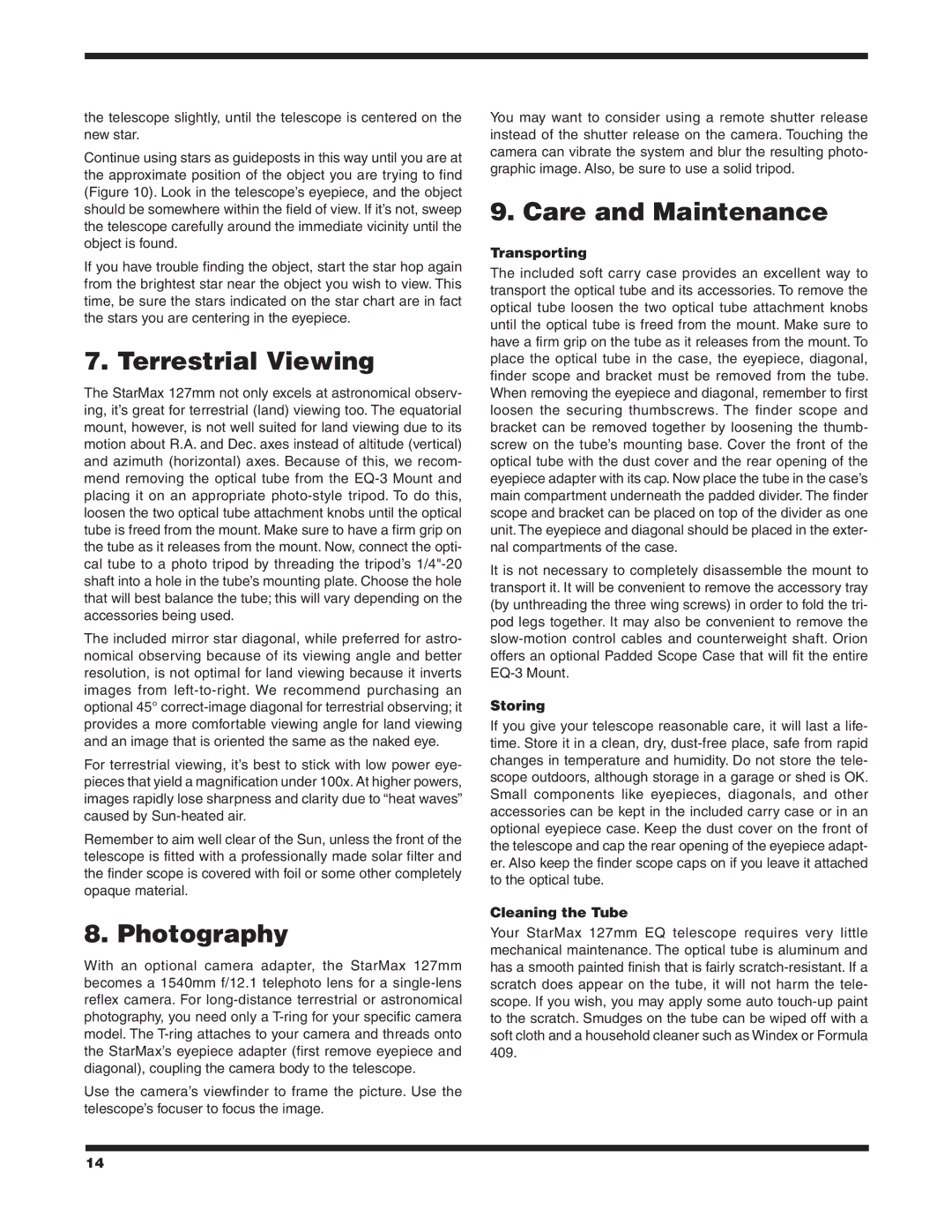
the telescope slightly, until the telescope is centered on the new star.
Continue using stars as guideposts in this way until you are at the approximate position of the object you are trying to find (Figure 10). Look in the telescope’s eyepiece, and the object should be somewhere within the field of view. If it’s not, sweep the telescope carefully around the immediate vicinity until the object is found.
If you have trouble finding the object, start the star hop again from the brightest star near the object you wish to view. This time, be sure the stars indicated on the star chart are in fact the stars you are centering in the eyepiece.
7. Terrestrial Viewing
The StarMax 127mm not only excels at astronomical observ- ing, it’s great for terrestrial (land) viewing too. The equatorial mount, however, is not well suited for land viewing due to its motion about R.A. and Dec. axes instead of altitude (vertical) and azimuth (horizontal) axes. Because of this, we recom- mend removing the optical tube from the
The included mirror star diagonal, while preferred for astro- nomical observing because of its viewing angle and better resolution, is not optimal for land viewing because it inverts images from
For terrestrial viewing, it’s best to stick with low power eye- pieces that yield a magnification under 100x. At higher powers, images rapidly lose sharpness and clarity due to “heat waves” caused by
Remember to aim well clear of the Sun, unless the front of the telescope is fitted with a professionally made solar filter and the finder scope is covered with foil or some other completely opaque material.
8. Photography
With an optional camera adapter, the StarMax 127mm becomes a 1540mm f/12.1 telephoto lens for a
Use the camera’s viewfinder to frame the picture. Use the telescope’s focuser to focus the image.
You may want to consider using a remote shutter release instead of the shutter release on the camera. Touching the camera can vibrate the system and blur the resulting photo- graphic image. Also, be sure to use a solid tripod.
9. Care and Maintenance
Transporting
The included soft carry case provides an excellent way to transport the optical tube and its accessories. To remove the optical tube loosen the two optical tube attachment knobs until the optical tube is freed from the mount. Make sure to have a firm grip on the tube as it releases from the mount. To place the optical tube in the case, the eyepiece, diagonal, finder scope and bracket must be removed from the tube. When removing the eyepiece and diagonal, remember to first loosen the securing thumbscrews. The finder scope and bracket can be removed together by loosening the thumb- screw on the tube’s mounting base. Cover the front of the optical tube with the dust cover and the rear opening of the eyepiece adapter with its cap. Now place the tube in the case’s main compartment underneath the padded divider. The finder scope and bracket can be placed on top of the divider as one unit. The eyepiece and diagonal should be placed in the exter- nal compartments of the case.
It is not necessary to completely disassemble the mount to transport it. It will be convenient to remove the accessory tray (by unthreading the three wing screws) in order to fold the tri- pod legs together. It may also be convenient to remove the
Storing
If you give your telescope reasonable care, it will last a life- time. Store it in a clean, dry,
Cleaning the Tube
Your StarMax 127mm EQ telescope requires very little mechanical maintenance. The optical tube is aluminum and has a smooth painted finish that is fairly
14
